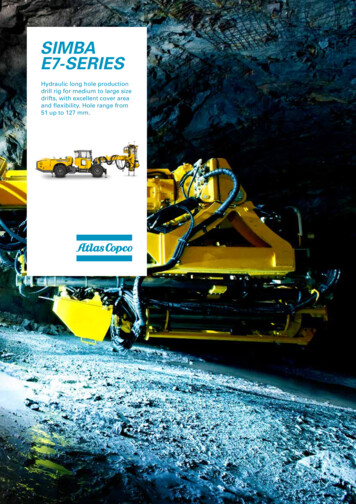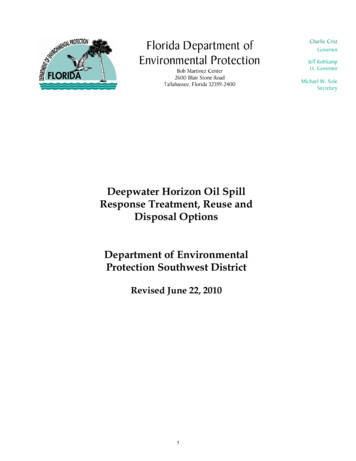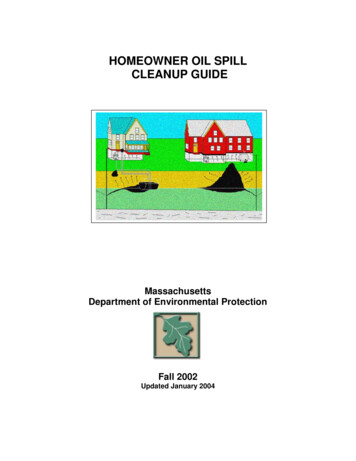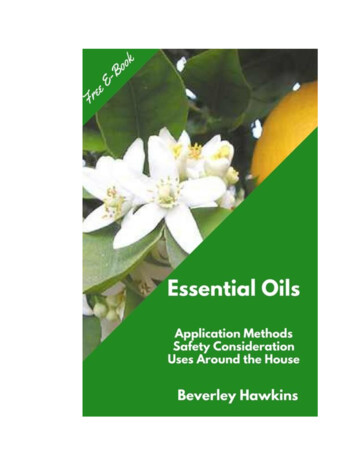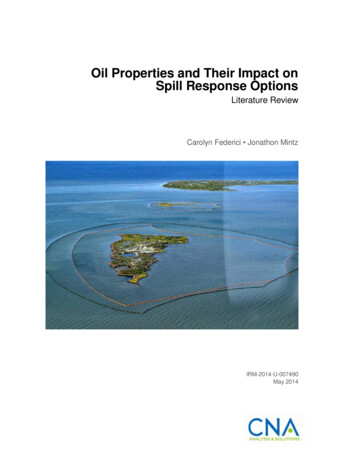
Transcription
Oil Properties and Their Impact onSpill Response OptionsLiterature ReviewCarolyn Federici Jonathon MintzIRM-2014-U-007490May 2014
Cover Illustration: Containment booms were used to contain oil spilled during the 2010 Deepwater Horizon oilspill in the Gulf of Mexico. Photo from: https://en.wikipedia.org/wiki/File:Oil containment boom.jpgApproved for distribution:May 2014Dr. Ronald FiladelfoDirector, Environment and Energy Research GroupCNA Resource Analysis DivisionThis document contains the best opinion of CNA at the time of issue.It does not necessarily represent the opinion of the Sponsor.Distribution limited to The U.S. Department of the Interior, Bureau of Safety and Environmental Enforcement (BSEE). Specific au thority: Contract #E13PC00009.Copyright 2014 CNAThis work was created in the performance of Contract Number E13PC00009. Any copyright in this work is subject to the Gov ernment's Unlimited Rights license as defined in FAR 52-227.14. The reproduction of this work for commercial purposes is strictlyprohibited. Nongovernmental users may copy and distribute this document in any medium, either commercially or noncommer cially, provided that this copyright notice is reproduced in all copies. Nongovernmental users may not use technical measures toobstruct or control the reading or further copying of the copies they make or distribute. Nongovernmental users may not acceptcompensation of any manner in exchange for copies. All other rights reserved.
Used to identifyClassification levelContentsExecutive summary . 1Introduction . 7Methodology. 8Literature search . 8Oil characterization. 11Oil properties. 11Oil weathering . 12ASTM standard categories. 13Literature review . 15In situ burning. 15Description of in situ burning. 15Measure of in situ burning effectiveness. 15Influence of oil slick thickness. 16Influence of oil properties on in situ burning. 17Limitations of in situ burning . 19Summary of in situ burning . 19Research recommendation for in situ burning. 20Dispersants . 20Description of dispersant chemistry and function. 20Measure of dispersant effectiveness. 23Influence of oil properties on dispersion . 23Summary of dispersants. 34Research recommendations for dispersants. 35Skimmers. 36Description of skimmers. 36Measure of skimmer performance . 38Skimmer performance . 39Emerging skimmer technologies. 46Summary of skimmers . 47Research recommendations for skimmers . 48Sorbents. 49Description and characterization of sorbent materials . 49i
Measure of sorbent performance .50Sorbent performance.51Summary of sorbents .61Research recommendations for sorbents.62Solidifying agents. 62Description of solidifiers.62Solidifier performance.63Summary of solidifiers .64Research recommendations for solidifiers .65Conclusions. 67Glossary . 71References . 73List of figures. 83List of tables . 85ii
Executive summaryIn responding to an oil spill, the effectiveness of a response dependson the timely selection of appropriate remediation options. Severaloil spill remediation technologies exist: In situ burning Dispersants Skimmers Sorbents Solidifying agentsThe effectiveness of each technology depends on the timeframe inwhich it is used. This time-dependent effectiveness is called the “win dow of opportunity.” The window of opportunity is determined bythe properties of the spilled oil, and by how these oil propertieschange over time after a spill. It is critical to understand both how oilproperties change over time, and how the effectiveness of responseoptions change as a function of oil properties.CNA conducted a literature review on the performance of oil spillremediation technologies—specifically, how their performance varieswith the properties of the oil spilled. This work was sponsored by theDepartment of the Interior’s Bureau of Safety and Environmental En forcement (BSEE).BSEE requested this study to compile oil spill remediation technologyperformance data from various sources into a single report. In par ticular, BSEE was interested in identifying work done on spill tech nologies in the peer-reviewed scientific literature. CNA identified andorganized performance data from government, industry, and scien tific literature, and formulated conclusions and recommendationsabout areas warranting further research and development in thisfield. CNA also organized system performance data from the variousliterature sources into a user-friendly database.1
Summaries of the major conclusions for each technology follow.In situ burningKey findingsThe most important factor governing the use of in situ burning in aresponse is the thickness of the oil slick, which should be at least 2–3mm to support burning. Slick thickness can be maintained by usingfire-resistant booms.Most oil is suitable for in situ burning. One important exception isvery light, refined oil products, for which burning poses a safety risk.The ability to use in situ burning as a response option decreases withtime and oil weathering. In situ burning might be suitable within 72hours after a spill. For heavy or thick oils, burning may only be effec tive for 1 to 2 hours after a spill.Recommendations for future research/developmentWe recommend that future research be conducted on novel technol ogies that may improve the window of opportunity for in situ burn ing, including herding surfactants and emulsion breakers.Preliminary work on these technologies suggests that they might in crease the window of opportunity for in situ burning by maintaininga favorable slick thickness, and by decreasing the water content ofemulsified oil.DispersantsKey findingsWe reviewed performance data on dispersants listed in the Environ mental Protection Agency National Contingency Plan (EPA NCP)product schedule. Of the 18 dispersants listed, 9 were evaluated inindependent tests. Only 3 of these (Corexit 9500, Corexit 9527, andFinasol OSR) performed as well in independent effectiveness tests asthey did in tests conducted by the product manufacturers and re ported to the EPA.Corexit 9500 is the only dispersant among those tested in the field todemonstrate consistent dispersion of oil slicks in field tests. Corexit9500 was also the only dispersant among those tested to effectively2
disperse oil in three types of independent laboratory tests (swirlingflask, baffle flask, and wave tank tests). This suggests that good per formance in all types of laboratory testing might indicate that a dis persant will perform well in the field.Finasol OSR was the only dispersant to demonstrate effectivenessequal to Corexit in independent laboratory tests.Recommendations for future research/developmentSince limited field trial data are available for Finasol OSR, it would bebeneficial to conduct additional field tests on Finasol OSR to deter mine whether its performance in the field is consistent with its labor atory effectiveness.SkimmersKey findingsUnlike other remediation technologies, skimmers can be used to re cover oils across a wide range of viscosities. Skimmers exist that caneffectively recover oil across all of the ASTM viscosity categories (Ithrough V).Many “rules of thumb” about the selection of oil spill skimmers arebased on performance tests conducted in the 1970s through the1990s. Because skimming technology has not changed appreciablysince that time, the standing rules of thumb are probably applicableto commercially available skimmers today.Emerging skimmer technologies are being developed in academicsettings to improve the oil recovery capabilities of oleophilic skim mers. Ongoing research includes the development of grooved pat terns on drum skimmers, novel oleophilic surface coatings, and theapplication of nanotechnology to novel oleophilic surfaces.Work by the Norwegian research organization, SINTEF, led to thedevelopment of highly effective skimmers for oil recovery in ice con ditions.Recommendations for future research/developmentWe recommend that emerging skimmer technologies be incorpo rated into commercially available designs. As the most effective3
skimmer test programs evaluated skimmers for a particular opera tional environment of interest (arctic conditions, for example), werecommend that targeted programs for the development of skim mers in operational environments of interest be developed and exe cuted.SorbentsKey findingsTests on commercially available sorbents demonstrated that syntheticsorbents yield better oil sorption capacity than natural materials. Pol ypropylene and aminoplast polymer sorbents exhibited the highestsorption capacity for light, medium, and heavy test oils. Inorganicmaterials exhibited poor oil sorption.In the academic literature, several materials under developmentyielded higher oil sorption capacity than commercially available pol ypropylene sorbentsRecommendations for future research/developmentAs synthetic sorbents yielded higher sorption capacities than naturalmaterials in the academic literature, we recommend that promisingadsorbent materials from the scientific literature—for example, elec trospun polymers—be further developed into commercial oil spillsorbents. We also recommend that promising oil adsorbent materialsbe incorporated into other spill remediation technologies such assorbent booms or oleophilic skimmers.Solidifying agentsKey findingsThe scientific literature on solidifying agents is sparse and limited inscope and scale. Most studies on solidifiers were done at the laborato ry scale and have only assessed their effectiveness in light, refined pe troleum products. The terminology used to define solidifiers isinconsistent, and standard metrics do not exist to describe or charac terize solidifiers for oil spill cleanup.4
New work in peer-reviewed journals suggests that gelating agents maybe promising for the recovery and solidification of oil from water.Recommendations for future research/developmentWe recommend that a standard definition be developed to define so lidifiers and to distinguish solidifying agents from sorbents. Standardtest methods and performance metrics should be developed to quan tify the effectiveness of solidifiers.5
This page intentionally left blank6
IntroductionIn oil spill remediation, it is critically important to understand the“window of opportunity” for various cleanup technologies. After anoil spill, timely decisions must be made about the most effective re sponse to mitigate the environmental impacts of the spill. Multipletechnologies are typically used in a spill response, including physicalmethods (skimmers, sorbents, or solidifying agents) and/or chemicalmethods (dispersants or in situ burning). Each technology has a dif ferent window of opportunity that strongly depends on the specificspill conditions and properties of the spilled oil.The purpose of this study was to conduct a literature review on oilspill remediation technologies. This report compiles data relating theeffectiveness of these technologies to the properties of the spilled oil.We included in situ burning, dispersants, skimmers, sorbents, and so lidifying agents in our review. We focused on studies reporting the ef fectiveness of remediation technologies as a function of oilproperties. From the performance studies encountered in the litera ture, we derived conclusions about their effectiveness for differenttypes of oil, and we identified areas warranting further research anddevelopment.In addition, we developed a searchable database to organize and citeperformance data for skimmers, sorbents, and dispersants. All per formance data were organized according to the test oil viscosity, al lowing users to compare the performance of different technologiesin similar oil types. In addition to viscosity, other oil properties are in cluded for dispersants, where more fidelity (other than viscosity) isimportant to categorizing performance. The combination of this re port with the performance database provides readers with the cur rent state of the art in spill remediation research. Details on the7
database development, structure, and contents are found in a sepa 1rate report.MethodologyIn performing this review and in constructing the database, we ac complished the following:1. Identified literature sources for in situ burning, dispersants,sorbents, skimmers, and solidifying agents2. Identified performance metrics describing each technology3. Identified a standard oil categorization method4. Compiled and organized performance data and oil propertiesinto project database5. Developed database queries and searchable structure6. Analyzed performance dataIn the following sections, we describe the literature search methodol ogy in detail.Literature searchWe conducted an extensive literature search to identify sources ofperformance data on several remediation technologies. We searchedfor performance data on dispersants, skimmers, and sorbents. We al so searched for studies on in situ burning and solidifying agents. Oursearch included academic journals and conference papers, govern ment reports, and reports published by private industry. Referencesare cited throughout this report, and a complete list of sources is alsoincluded in the project database.In our search of academic publications, we gathered sources pub lished since 2000 using both Google Scholar and EBSCO Discovery1. The accompanying report that documents the project database is: C.Federici and J. Mintz, Oil Properties and Their Impact on Spill Response Op tions: Database Development and User Guide, The CNA Corporation, IIM 2014-U-007467, 2014.8
Service. EBSCO Discovery Service searches the following databases:Medline, PsycEXTRA, PsycINFO, Business Source Complete, Aca demic OneFile, Academic Search Complete, Military and Govern ment Collection, GreenFILE, Agricola, Science Direct, and Elsevier.Government reports and test programs were identified from theUnited States (Environmental Protection Agency (EPA)) and Envi ronment Canada.Our search of private industry reports led to the identification of sig nificant oil spill test programs conducted both domestically and in ternationally. We drew on spill cleanup test programs conducted byBP, SINTEF (a Norwegian research organization), and SL Ross Envi ronmental Research.9
This page intentionally left blank10
Oil characterizationThe analysis and characterization of crude oil or refined petroleumproducts is a complicated endeavor. These oils are heterogeneousmixtures of hydrocarbons with physical properties that change de pending on the exact oil composition, and on the environmentalconditions.Oil propertiesBoth the chemical composition and the physical properties of oilshave been carefully analyzed and documented for thousands of crudeoils and refined oil products [1][2]. Physical properties influencingspill cleanup include viscosity, density, API gravity, pour point, flashpoint, and the chemical composition of the oil (i.e., wax content andSARA (saturated hydrocarbon, aromatic hydrocarbon, resin, asphal tene) content). Common oil properties used in spill remediation re search are defined below, along with their common units of measure: Viscosity: The resistance to flow of a liquid (common units in clude pascal-seconds (Pa·s), centipoise (cP), or centistokes(cSt)) Density: Mass per unit volume (usually reported in g/cm or3kg/m )3 API gravity: A dimensionless form of density, describing a flu id’s density relative to water (a dimensionless number, reportedwith a degree mark ( ) as the unit. The API gravity of water is10 . Flash point: The lowest temperature at which a substance canvaporize to form an ignitable mixture ( F or C) Chemical composition: The content of the following chemicalgroups is often reported for crude oil:— SARA content: The content of saturates, aromatics, resins,and asphaltenes in crude oil. The content of SARA compo nents is correlated to the bulk physical properties of oil.11
Saturate and aromatic contents are negatively correlatedwith viscosity (high saturate or aromatic contents correlatewith low viscosity oils) [3]. Asphaltene content is positivelycorrelated with oil viscosity. The high viscosity observed inheavy oil is related to its asphaltene content because asphal tene molecules tend to tangle, causing high oil viscosity [4].In addition, oils with high asphaltene and resin contentstend to form stable emulsions [5].— Sulfur: The content of sulfur-containing molecules in crudeoil— Wax content: Content of organic compounds that are mal leable near ambient temperature. Waxes are typically insol uble in water, and soluble in organic solvents. Wax contentis positively correlated with oil viscosity [6].One comprehensive database of oil properties (including more than1,000 crude oils and refined petroleum products) is included in theADIOS (Automated Data Inquiry for Oil Spills) software package.ADIOS—an oil spill modeling software package developed by theNational Oceanic and Atmospheric Administration (NOAA)—isavailable to download free of charge from NOAA’s nd-chemical-spills/oil spills/response-tools/adios.html.Oil weatheringIn addition to understanding the physical and chemical properties ofoil and petroleum compounds, it is critical to understand how theseproperties change over time during a spill incident. The process bywhich oil properties change during an oil spill is known as “weather ing.” Oil weathering is a complex process, and detailed computation al models exist to predict how oil properties change during a spill as aresult of weathering [7][8]. During weathering, oil becomes moreviscous through evaporative loss of volatile compounds and by col lecting water (a process known as “emulsification”). The degree andrate at which oil properties change as a result of weathering dependon the type of oil and on the conditions surrounding the oil spill(weather, sea state, location of spill, etc.). A detailed discussion of oilweathering is beyond the scope of this study. We acknowledge that oilweathering is a critically important factor governing the selection of12
remediation methods, and we mention the impact of oil weatheringin our discussion of cleanup technologies where appropriate.ASTM standard categoriesWhile many of the physical and chemical characteristics of oil influ ence remediation options, most studies evaluating cleanup technolo gy describe oil using only a few key, descriptive properties. Often,viscosity, density, and API gravity are used to characterize test oils.ASTM developed many standard test protocols for the testing of spillcleanup technologies, including standard categories to describe testoils. Table 1 and table 2 show ASTM categories to describe oil in thetesting of skimmers and sorbents, respectively. (The ASTM standardfor in situ burning does not include viscosity categories for test oils.Instead, oil fire point and slick thickness are used to guide the selec tion of ignition devices.) In this paper, we described test oils accord ing to these ASTM categories. For skimmers and dispersants, we usedthe categories described in table 1; for sorbents, we used the catego ries in table 2. In the project database, all studies are sorted accord ing to the ASTM categories listed in table 1.Table 1. Oil categories for skimmer testing(ASTM method F631-99)CategoryIIIIIIIVVTable 2.Viscosity (cSt)Density (g/mL)150 – 2501,500 – 2,50017,000 – 23,00050,000 – 70,000130,000 – 170,0000.90 – 0.930.92 – 0.950.95 – 0.980.96 – 0.990.96 – 0.99Oil categories for sorbent testing (ASTM method F726)Oil descriptionLightMediumHeavyWeathered (added in 2012)Viscosity range(cP)Density range3(g/cm )Example oils1 – 10200 – 4001,500 – 2,5008,000 – 10,0000.820 – 0.8700.860 – 0.9700.930 – 1.0000.930 – 1.000Diesel fuelLight Crude oilBunker C oilEmulsified crude oil13
This page intentionally left blank14
Literature reviewIn this section, we summarize the literature search for each technolo gy separately (in situ burning, dispersants, skimmers, sorbents, andsolidifiers).In situ burningDescription of in situ burningIn situ burning is the oldest technique used in oil spill cleanup andinvolves the controlled burning of oil slicks to eliminate spilled oiloffshore before it reaches the coastline. This technique has been suc cessfully used in many large spill responses, including the 2010Deepwater Horizon spill, where an estimated 200,000–300,000 barrelsof oil were burned at sea [9]. Benefits of in situ burning include ex tremely efficient and rapid oil removal (efficiencies often exceed 903percent with removal rates on the order of 2000 m /hr) [10]. In ad dition, when successful, no further downstream oil separation or re moval processes are necessary following in situ burning. Onceburned, the oil is eliminated. While typically effective, the choice touse in situ burning involves many factors, including environmentalconsiderations (burning oil releases toxic fumes), operational con straints (the availability of fire-resistant containment booms and ap propriate igniters at the site of the spill), and technical constraints(effectiveness of the technique for the particular oil spilled).Measure of in situ burning effectivenessHere, we consider the effectiveness of in situ burning as a function ofoil properties. The operational challenges and environmental impli cations of in situ burning will not be discussed, nor will the factors in volving equipment selection for in situ burning.Three factors consistently emerged as the most important in deter mining the effectiveness of in situ burning in a spill: (1) oil slickthickness, (2) oil properties (flash point, volatility, and API gravity),and (3) oil emulsification. We will discuss each of these factors indi 15
vidually and explain how these factors can help to identify a windowof opportunity for using in situ burning in a spill.The effectiveness of in situ burning is usually described according toits efficiency, defined as the percentage reduction in slick thickness asa result of burning. Slick thickness and oil properties (mainly APIgravity) are thought to influence the effectiveness of in situ burning.These properties are discussed in the following subsections.Influence of oil slick thicknessOil slick thickness is a significant consideration when conducting insitu burning. A slick thickness of at least 1 mm is required to achievesustained burning (most slicks, however, are ignited when they are atleast 2–3 mm thick). When slick thickness is reduced to less than 1mm, burning is no longer sustainable [11][12].Figure 1.In situ burning during Deepwater Horizon spill responseA containment boom is being carried between two boats to facilitate and control in situburning [9].Very dense or highly emulsified oils require thicker slicks (3–10 mm)to initiate burning [11]. This is because highly emulsified oils are dif ficult to ignite and burn (as discussed in more detail in the next sub section). Increasing slick thickness is one way to improve theapplicability of in situ burning for highly weathered oils. Unemulsi 16
fied oils can initiate and sustain burning with thinner oil slicks thanemulsified oil, regardless of their properties. Unemulsified oil re quires a slick thickness of 2–3 mm to initiate and sustain burning[12]. To maintain the slick thicknesses sufficient to support in situburning, fire-resistant booms are deployed around the edge of the oilslick, as shown in figure 1.Herding surfactants to maintain slick thicknessSurfactant molecules (e.g., soaps or detergents) contain both hydro philic (water-loving) and lipophilic (oil-loving) groups. Herding sur factants, which form layers on the water surface, can rapidly contractoil slicks, thereby increasing their thickness. A series of tests conduct ed by Buist and others demonstrated the effectiveness of herders tofacilitate in situ burning in large-scale tank and field trials in icy con ditions [13][14]. A literature review by SL Ross Environmental Re search in 2010 highlighted the fact that herding surfactants areeffective in both fresh and salt water to facilitate in situ burning [15].Influence of oil properties on in situ burningTo ignite oil, vaporization (the transition of some oil from the liquidto gas phase) is required to initiate a fire. Many oil properties—suchas vapor pressure, volatiles content, flash point, API gravity, and de gree of emulsification—are correlated to how well oil will vaporizeand ignite. Oils that readily vaporize (oils with high vapor pressure)are easier to ignite than those that do not readily vaporize (oils withlower vapor pressure). For in situ burning, however, virtually any typeof oil will burn on water if the oil slick is of sufficient thickness [12].Highly emulsified and heavy oils are more difficult to burn than lightoils because they do not readily vaporize. Emulsified oils typicallyhave burning efficiencies of 30–60 percent, whereas very light oils,such as gasoline, burn at 95–99 percent efficiencies [12]. Severalstudies demonstrated that highly emulsified oils can be burned afteradding a chemical emulsion breaker to deemulsify the oil [11][16].The addition of an ignition primer, such as diesel fuel, can also beadded to heavy or emulsified oils to enable their ignition [12].Some refined products are not well suited for in situ burning for safe ty reasons. Certain highly flammable refined fuels present fire risksdue to rapid evaporation and spreading. Oils with flash points below17
37.8 C and vapor pressures below 40 psi should not be consideredfor in situ burning due to the risk of an uncontrollable fire. Suchflammable products include gasoline, propane, and butane [11].While the physical properties of oil help predict its suitability for insitu burning, in a time-critical spill situation, having a simple set of se lection criteria for cleanup methods allows for the most efficient,timely cleanup response. API gravity was identified by SL Ross Envi ronmental Research as a single, good predictor of success for in situburning. Based on testing of 17 crude oils, guidelines for in situ burn ing as a function of API gravity were developed. Light oils with APIgravities higher than 35 burned easily, and heavy oils with API gravi ties less than 20 were difficult to ignite or unignitable. Oils with in termediate API gravities ranging from 20 to 35 had various degreesof ignitability, depending on their degree of emulsification [17]. Ta ble 3 shows the in situ burning efficiency of various fuels as a functionof API gravity. As a rule of thumb, oils with API gravity greater than20 are suitable for in situ burning.Decreased burning efficiency was reported over time with evaporativeloss and oil weathering. The impact of weathering on burning effi ciency is more pronounced for heavy oils than for light oils. In onecase, the ability to burn light oils did not decrease dramatically withoil weathering, but the ability to burn heavy oils significantly de creased with increasing water content [18]. Additional work on theeffect of weathering on in situ burning has been incorporated intothe SINTEF oil weathering model. This software package predictswindows of opportunity for in situ burning for oils of various proper ties as they weather and accumulate water over time [19].Table 3. In situ burning properties of various fuelsFuel typeEx
In oil spill remediation, it is critically important to understand the "window of opportunity" for various cleanup technologies. After an oil spill, timely decisions must be made about the most effective re sponse to mitigate the environmental impacts of the spill. Multiple technologies are typically used in a spill response, including .


